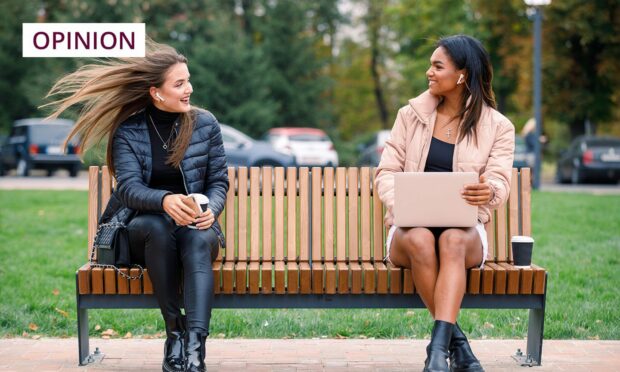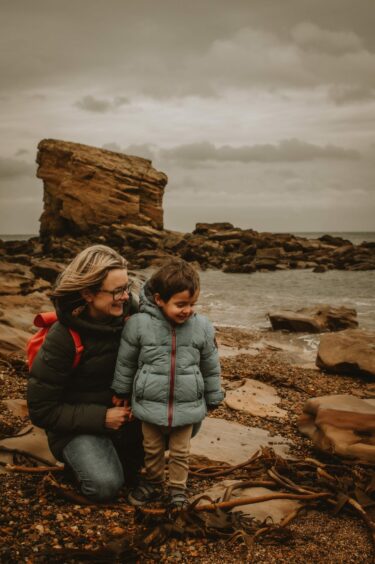“But I didn’t think we were meant to talk to strangers, mummy!”
My five-year-old isn’t wrong.
Before Maya started school, we drummed it into her that she mustn’t speak to or go off with anyone she doesn’t know.
And yet here I am baring my soul to someone I’ve only just met at the playground.
Not for the first time either – in fact this is a regular occurrence.
It’s a tricky one to explain to her.
Obviously keeping my children safe is my number one priority above everything else, and clearly, Maya’s too little for a nuanced chat about judging each situation individually.
That would blur the lines and potentially put her in danger.
But I also want to raise humans who are able to live life to the full, which – for me – means seeing every day as an opportunity to make a connection with somebody new, being open to what I’ll call the chance encounter.
It could be the journalist in me – I’ve been fortunate to have been able to do exactly this for a living for more than a decade.

Looking back over the years, however, I think the impulse might be more innate than that.
Since I can remember, I’ve always loved hearing people’s stories, and, when I recall the places I’ve visited, the people I met there come to mind first.
‘A friend may be waiting behind a stranger’s face’
Conversations with a warrior guard at a campsite in Kenya’s Masai Mara and a beautiful beaded bracelet gift I still treasure some 25 years on.
An elderly couple sitting on ‘their’ bench in New York’s Central Park who declared they’d never used their oven, opting instead to eat out in restaurants for all their meals.
A flirtatious tête-à-tête with an ice-cream vendor in Sirmione on Lake Garda, probably one of the main reasons I began studying Italian.
A chef on our honeymoon in Brazil (mine and Mr R’s that is – not the Italian waiter) inviting us into his kitchen for a masterclass.
And, just this week, sharing a fellow mum’s happy place on a stony Northumberland beach – a journalist-turned-photographer, as it happens, who within minutes of meeting us had taken the most stunning photos of me and my son Kamran.
If we are really lucky, sometimes these kind of impromptu meetings blossom into long-lasting friendships.
As Maya Angelou, one of my favourite authors, wrote in Letter to my Daughter: “A friend may be waiting behind a stranger’s face.”
Of course, more often than not, you’ll never see the person again, but that isn’t the point.
Because the significance of an experience isn’t solely determined by its duration or longevity.
Not all exchanges are meant to bloom into relationships and not all relationships are meant to last forever.
Human contact important in digital age
The important thing is the human contact, the connection in that particular moment, whether it ends up being an entire chapter, single page or simply a footnote in the story of your life.
And this is becoming even more crucial in a world where almost everything can be accomplished exclusively online and where people are routinely working from home at least some of the time, as ONS data reveals.
Between October to December 2019 and January to March 2022, home-working in the UK more than doubled from 4.7 million to 9.9 million people.
Homeworking in the UK more than doubled between Oct to Dec 2019 and Jan to Mar 2022 – from 4.7 million to 9.9 million people https://t.co/Cqtqf8FHWC pic.twitter.com/qlNd4cnuEX
— Office for National Statistics (ONS) (@ONS) July 11, 2022
Moreover, analysis published in May shows that most people who took up home-working during the Covid-19 pandemic plan on maintaining it in some form through a hybrid set-up in the future.
Since moving to the north-east of England from London two years ago, I’ve been blessed to have been able to meet lots of new people – through other mums and while out and about with the kids.
In contrast, Mr R, who works from our top floor (I call it the penthouse, he prefers prison), can go days, a whole week even, without interacting with anyone outside of the family.
He can’t be alone in that.
It’s not an exaggeration, therefore, to warn that we risk losing our appetite for face-to-face communication, indeed our ability to mix.
Let’s grasp chance to socialise
I’ve no wish to bad-mouth technology. Advances in recent decades have changed how we communicate beyond our wildest dreams, in many ways for the better, for example enabling families spread out around the world, like my mother-in-law’s, to stay in touch more easily and consistently.
As we harness these opportunities, however, and become more digitally connected both in our professional and personal lives, we must strive to preserve face-to-face connectivity too.
Because spending time in person is surely one of the best parts of the human condition?
With that in mind, let us grasp every chance to socialise.
Being open to building new connections will make our lives richer.
Lindsay Razaq is a journalist and former P&J Westminster political correspondent who now combines freelance writing with being a mum












Conversation